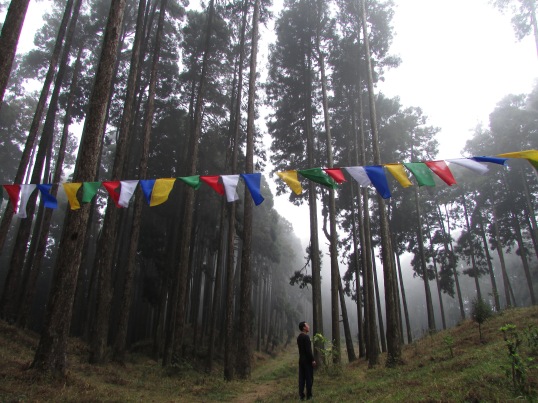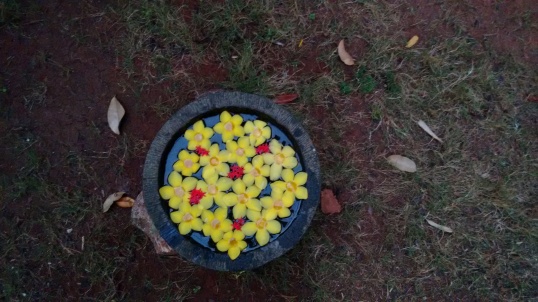I wake up to the silent afternoon breeze and lead myself out of the hut as quietly as I can. Stopping at the porch, I start to wear my shoes rather absentmindedly – they’re almost a part of my body now, what with 12 hours of continuous accompaniment. The silence is only broken by the distant clattering of vessels in the kitchen and the heavy breathing of the weary trekkers slumbering inside the hut. It is a warm and sunny afternoon – A stark difference from our encounters of the last five days. Sunlight is good, I tell myself, stretching my numb limbs and making my way towards a big rock across the hut. I am basking in this glorious sunshine and looking over the huts that lay ahead of me, amidst the vast expanse of snowy terrain that is outlined by towering mountains. The mules are busy grazing whatever little vegetation they can find below the snow, and I find myself slipping into a recollection of the events of the last twelve hours…
As we stood gazing into the velvety sky, our campsite was bustling with activity – Trekkers busy with last minute prepping, micro-spikes clinking, kitchen staff hustling with packed food, the guides instructing each other in Nepali and the mules whinnying away. I remember thinking to myself how odd it was that while I was here, waiting to kick-start this adventure at 1 in the morning, all my family and friends were probably already asleep, oblivious to all the adrenalin rushing through my veins!
We collectively prayed to the mountain gods to support our endeavor with clear weather, and started off towards Lamuney which was another 4 km of pretty much flat walk. We walked silently, pausing frequently to sip some water but largely following our guides who had now reduced to mere torch-lights in the far. ‘This is the thing about trekking in the night’, I thought to myself, ‘It is probably nature’s way of showing us that we will always find light at the end of the tunnel’. We soon reached Lamuney (well in time), eager to continue to View Point 1 (VP1) to catch the sun rise over the glorious Kanchenjunga range.
My pleasant reminiscing is interrupted by the sound of Sancha bhaiya and Ita Sing (our guides) giggling their way out of the kitchen tent. I smile to them and they smirk shyly and giggle away towards the mules. I dawdle my way around the flat land facing Pandim and realise that the melting snow has rendered the terrain mucky as soon as my foot slips into one of those mucky patches. I lift my foot, only to find the shoe dripping in different shades of brown. Hopping over to a drier spot, I take the shoe off and slip into a recollection of the events of the morning, together with cleaning the shoe…
The hike from Lamuney to VP1 was arduous. Under normal circumstances, we would have started for VP1 from the Lamuney campsite – but we had to cover this distance on the summit day itself, having had missed a day’s time on account of bad weather at Dzongri. What sounded like a measly 3.5kms was turning out to be the most hardcore thing any of us had done and rightly so – 15,200 ft was no mean feat! Sancha bhaiya had told us that 5.45 am was the perfect time to witness sunrise from VP1 and honestly, that was our only motivation to keep going. It was a test of endurance and patience, for the gradients were extremely steep and every time I felt like I was there, Sancha bhaiya would shout to say “thoda aur aage hai (it is a bit further away)”. At 5.30 am, I realised that I was still far away from VP1. Andi was marching ahead, breaking trail for the rest of us while Raylene and Jude were catching up to Sancha bhaiya and me. I kept asking Sancha bhaiya if I’d be able to make it in time for sunrise and he responded each time with an “araam se (easily)” and an impish smirk. We were 15 minutes away from being the first batch to summit Goecha La that season and of course our 19 year old guide was as excited as us!
The last leg was legitimately formidable, and we were ascending through knee-deep snow. Each step took herculean effort, and it was only then that Sancha shouted “Jaldi aajao abhi speed badhao..sunrise hone waala hai! (Come quick, speed up.. the sun is going to rise!)”. I pulled in all effort to move ahead as quickly as I could, walking along the treacherous trail – one mis-step in the deep snowy track, and a big fall down the valley eagerly awaited me. I had barely reached the end of the trail when Sancha bhaiya shouted, “Yehi hai View Point 1… welcome! (This is View Point 1… welcome!)”. I looked up to witness the first rays of sun falling on the illustrious Mt. Kabru and then slowly reflecting on the whole of the Kanchenjunga range. It felt like magic – to be standing there, barely 2kms from the world’s third highest peak, and watch this phenomenon. It felt like nature had placed those glimmering rays on the range, just like a veil over a bride’s head. If there was a quantifiable way to express gratitude, then it had to be this… and here.
I am swiftly pulled out of my dream world by the animated conversation between Raylene and Andi. They are walking around deep in discussion about what sounds like college… or music. I begin to wear my now not-so-wet shoe and see Jude walking towards us. Even from a distance, it is easy to tell that he is playing some of his favourite Trishna Gurung Nepali folk songs. I start to hum Asaar in my head as I walk towards the group. I think for now and forever, Asaar is only going to remind me of the summit and the tears…
जिन्दगी कहिले घाम कहिले पानी, लै बरी लै
Life is sometimes like the sun and sometimes rain
माया नै सबै भन्दा ठुलो कुरो रैछ नि है
Love is the greatest thing in the world
चारैतिर निला निला आकाश नै छायो है
Big Blue clouds surround us
वरिपरि लागेको यो कुहिरो हरायो है
The fog surrounding us gets dispersed
मनलाई साँचो राखी हिँडिरहेछु
I keep my heart pure and walking
म तिम्रो साहारामै बाँचिरहेछु, मायालु
I am living for you, Darling….
All of us soon re-group and mull over the happenings of the day with renewed vigour. The fatigue from our noteworthy 14.5km long hike seems to have faded away like the green on autumn leaves. We are happily gupshupping about the day that was and how lucky we are to have been able to get out of Dzongri and finally made it to the summit.
We hiked from Dzongri to Thansing via Kokchurang, which is usually a preferred campsite among trekkers (not to mention the number of ghost stories about this place). But we decided to give it a miss and camp at Thansing instead, thanks to the snow. The route from Dzongri to Kokchurang was carpeted with snow and needless to say, we were breaking the trail through most of the route. It was a beautiful day and the sky was slowly clearing to reveal its perfect blue shade. We marched along the route, having received ample warning from Jude that the descent to Kokchurang was going to be steeper than we imagined, and our knees were going to take quite a beating.
When we finally descended to Kokchurang – after a lot of puffing and panting, knee-jerking and micro-spiking – we were greeted by the utterly gorgeous Prek Chu river that flowed in all its force and glory. We quickly ran towards the river to touch its ice cold waters that were gushing through snow-laden boulders. The exuberant Prek Chu along with the pine and oak trees sprinkled with snow along its bed made for an unforgettable sight! The place was so scenic and calm, but we had to start towards Thansing, albeit reluctantly…
Our reminiscing is interrupted by Ita Sing and the big bowl of popcorn in his hand. Amidst all our dialogue, we had forgotten how hungry we were, and the popcorn only makes us aware of this reality. Just as we begin to grab the popcorn, Sancha bhaiya waltzes in with hot chai for us. We are gorging on the hot chai and popcorn, and of course fully intend to continue our walk down our recently walked memory lane. We realise that none of this conversation is complete with an elaborate discussion on our 3 day long stay at Dzongri…
We ended up spending a good 3 days in Dzongri, as against the initial two day plan – snow played truant to our plans. We were positively confined to the four walls of our trek hut for most of the time (except the mandatory pee-breaks) as it snowed away to glory. The visual outside our hut changed from barren brown to whirly white in no time. And even though the outdoors looked mesmerizing and a few of us experienced our first snow-fall, the enthusiastic trekkers were exasperated with staying indoors in this newly christened ‘hell-hole’.
We kept stepping outside to play some games and do the ‘thermal dance’ to keep ourselves active, but the snow fall kept pushing us back indoors. The weather on all three days was pretty dull and the skies were filled with the darkest clouds, making us feel like we had caused some major upset up in the heavens. Our visit up Dzongri top was also mired in thunder and rain, and we rushed back down with no views of the gorgeous Kanchenjunga range.
Even though Andi merrily networked with the other trekkers who were stuck with us in Dzongri, we were collectively worried about our prospects for the summit and started to make alternate plans. The next day was going to be our make or break day. We were going to move out of Dzongri anyway – either back to base or towards Thansing. We were pretty much blank about what lay ahead of us.
A loud knock on the door awoke us on the next morning at 5 – One of guides walked in and declared that the sky had cleared! We rushed to pack ourselves and head to Thansing! I’d like to call it providence…
Our engaging discussion is abruptly paused with the realisation of sunset that is heavenly unfolding before us. We are gazing at the palette of colours as it dissolves into the endless sky, blissfully aware that time has no meaning in this moment. Just as the sun sets behind the Pandim, into the Kanchenjunga range, a bunch of clouds lumber in and cover themselves over the beautiful mountains… just like curtains closing over the stage after the final encore.
We silently walk back towards the hut, content and deeply grateful – knowing in our hearts that this was nature’s gift to us and us only 🙂
PS: Thankyou Jude and Tour de Outdoors, for giving us the experience of a lifetime. Forever grateful 🙂





















































